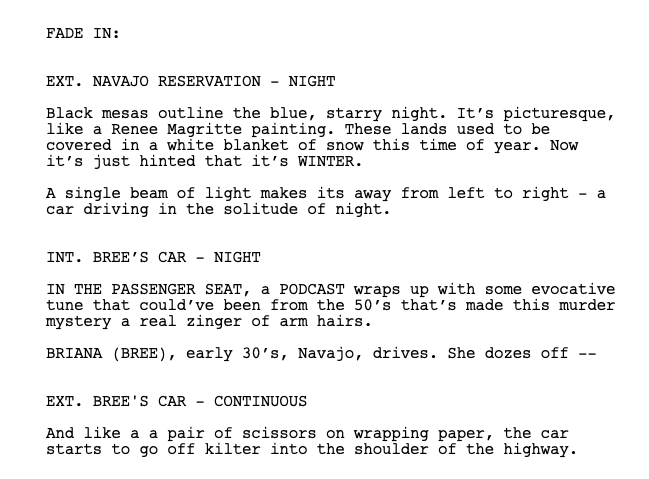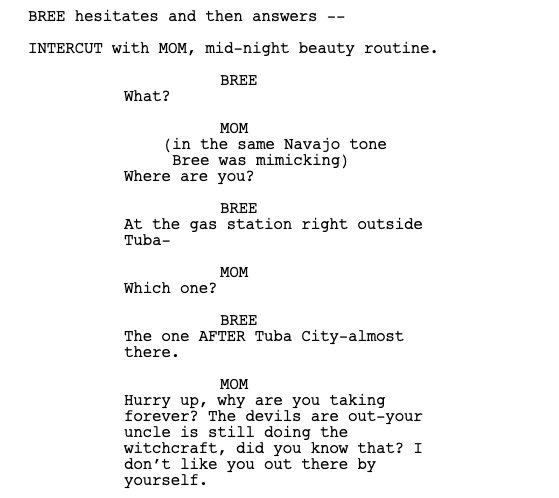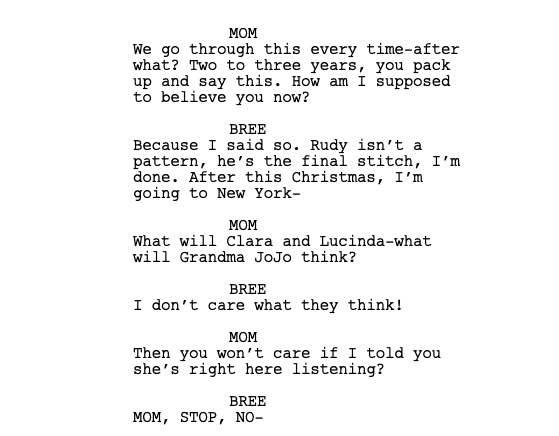
Safety in Numbers: Bringing Community to the Screen Through Language
August 5, 2025
Filmmaking becomes a way to preserve Navajo language and culture, where words gain deeper meaning through personal memory, family, and lived experience.
By Chris Hoshnic
This essay is part of the Crocker’s Indigenous Voices in Film project, an initiative dedicated to exploring the artmaking practices of Indigenous peoples in the Sacramento and Northern California regions through the lens of film, video, and media arts. For more information on the Indigenous Voices in Film project, follow this link.
March 2018. It is morning. The fringes of Gallup plunge into a chilling stillness. The long shadows of the cast and crew reach across the rugged red rocks and sagebrush. Frost lightly dusts the ground. Melissa, our short film’s actress, and I discuss the use of daʼahijigą́, or “fight,” for a scene. This is not written into the screenplay, but I want to incorporate our Navajo language in some way. Instead, “family” comes crumbling out of my mouth, as a by-product of a dispute in my own family. This nature of language—how often do I find myself lost in this space of translation while cultivating a new way of expression? Daʼahijigą́ does not directly mean “family.” It lives nowhere near this word at all. This is where I find myself when working with film. How can I create a world where my filmmaking serves as a tool for preserving culture, rather than erasing it? What if I use these technologies unnatural to Navajo living not only to communicate but to strengthen my ties to the community and my mother tongue? "What do you mean by ‘family’?” Melissa asks. I shake loose from the space of translation as I hear the crew whisper to each other.
Before long, I hold the camera up to Melissa's face and yell, "Go." Our short film is about a young Navajo mother’s journey back to the reservation to see her daughter from the big city in the middle of winter. It is a mirror telling of my own parents living in Phoenix, Arizona and leaving me with my grandparents in my fragmented memory of the reservation. This messy tapestry of frustration and love, and having to be away from my mother and father, has disrupted my relationship to the Navajo language. Money was our priority, and it was Melissa’s character Bree’s as well. How monetary value is translated in Navajo for my characters is within their relation, or lack thereof, with the distance between each other. The wider the distance, the more money my protagonist can obtain. At least this was the argument from Bree’s mother. This was called, nízaadę́ę́’, or “far away.” According to Bree’s mother, money was “far away.” So when we refer to nízaadę́ę́’, we are truly talking about “money.”

Several years after my grandfather died, I moved back to Phoenix to be closer with my own parents. One Saturday summer night, my parents came home from the local bar. I recall hands gesturing wildly, slicing through the air. The need to be heard, to be understood, their words in Navajo, like sharp and pointed objects scattered across my room. It was the first time I ever saw either of them this way. Time was catching up to them. They were still in mourning for my grandfather. A week later, we went to see a medicine man and found a spiritual connection between them and a certain kind of pain. “The cancer,” the medicine man called it in Navajo, is “in the nape of your necks.” He performed his duties and asked us to return after four days to complete the removal of “the cancer.” In the car, I asked my father what the medicine man meant when he was pointing to his neck. My father said, in Navajo, “Beartooth.” Silence blanketed the windows, heavy but comforting. We stopped at a gas station with the promise that we would find our way back to each other. A bottle of Pepsi in one hand and sunflower seeds fisted in the other, we drove back to the big city and never returned to complete our blessing.
Years later, I discovered what my father and the medicine man meant by “Beartooth,” and “cancer.” This translation, this experience clamored, meant in its truest form, “conflict.” The “conflict” was in the nape of our necks, meaning we had "ears up to our shoulders.” We were "holding a bowling ball out in front of us." English metaphors of the same concept, meaning stress, anxiety or conflict, have a more direct relation to the body. However, in our short film, we say daʼahijigą́ in place of this conflict.

Finding what makes an Indigenous language authentically represented on screen is to take safety into account. When I use the Navajo language, I consider all levels of learning in terms of safety. Instead of “where,” I ask “how” these safe spaces can ensure Navajo, in its evolution, can move and still be autonomous. My practice is in how it is rooted in my own experiences, memory, and community. In particular, I use single Navajo words and phrases within context, or scenes in this case. In poetry, these scenes are often called “stanzas,” meaning "rooms." In those particular rooms, it is the filmmaker’s job to create safety. In horror films, this can be between horrific scenes when the characters are in their regular home lives, interacting with each other. Or more broadly, this is when the protagonist finds solace in a story outside the narrative, such as a love interest, a best friend, a maternal figure, or a mentor. Language honors relations this way through familiarity when two or more people are speaking. Finding peace in a narrative is integral for when the protagonist steps out of those safe spaces and relations begin to have a sense of urgency. This is where we want to save the relationships we came to love, or in the case of Indigenous languages, where we began to reclaim and properly represent. In this endeavor, I learned Navajo suffers a great deal of translation. By constructing language, we are dependent on a certain experience and relationship towards and from how a word or a phrase is being used. The brevity of a thing here, as coined by Dr. Shaina Nez, then becomes less about the conciseness of the words but the economy of those words—the time in which those words mean something other than what we mean for them to be. In film, I try to make these spaces, or rooms, that house my relationship to the Navajo language become less about the representational image like a scarf or moccasins and more about the meaning those things carry. Not many are aware that Navajo moccasins were made of White Shell as the soles and the top representing Mother Earth. This is part of our creation stories. Often, they are ceremonial wear, however we tend to find these visuals in film to only mean a person is Navajo, with no true meaning. The same goes for Indigenous languages: If we are not intentional about the safety of these words and images, then representation will only be as hollow as it was before we came to take charge of our stories.

As the wind cuts through the bare branches, we complete the scene. A sharp bite of cold air swipes across our faces. "It's not there yet," I say. Melissa nods, but the tension in her shoulders is palpable. The effort to sound natural when speaking Navajo only makes the stiffness more obvious. It is not that Melissa did not understand the scene—she knows the lines, knows the beats—but something in the space between her and the language kept blocking the truth. Like trying to catch water in a cupped hand. I stop rolling and tell Melissa the story of my family and the medicine man. I do not tell her what to do; I guide her with my story, with a sense of our film’s safety to find her character’s truth. And in that sense, in that exchange, the scene came alive—an understanding of where the word daʼahijigą́ and nízaadę́ę́’ came from, perfectly aligned.
Language is not merely a collection of words; it is woven into the fabric of culture, history, and identity. The study of a language changing over time, of English especially, has more data compared to any Indigenous language documented. I can argue that filmmakers may be the first documentarists of their Indigenous languages by showing an accurate representation of their uses within their lifetimes. Understanding and learning Navajo is not enough to facilitate hope for future generations that they, too, can learn it. It is the relationships we nurture that give us our language, which then we can pay forward. This is what makes Indigenous languages unique in practice. Filmmaking, like relationships with family or friends, houses its own languages. Each and every scene is a separate room full of memories and experiences that can feel universal. It is our job as Native speakers and artists to assemble it, whether that is in a single word, or a phrase, or an entire sequence of scenes that bring a community safety. This is what audiences will carry with them long after the film is over. Daʼahijigą́ now not only means “to fight”or “they are fighting”—it means a family in distress or a miscommunication between loved ones. Nízaadę́ę́’ traditionally means “far away,” but it can mean wealth or an act of love as it does for our protagonist. Working with the Navajo language on film is extremely complex, but with the care and understanding of its speakers, it can be one of the most rewarding experiences of building community.
Chris Hoshnic
Chris Hoshnic is a Navajo Poet, Playwright and Filmmaker. A recipient of the Poetry Northwest 2025 James Welch Prize, Hoshnic’s work has received support from Indigenous Nations Poets, Playwrights Realm, Tin House, Juniper Institute and more. His work has been published in POETRY, Kenyon Review and elsewhere. He currently directs Diné Kids Film Club, an Indigenous youth project dedicated to giving resources and networking opportunities for young Native filmmakers.
The Indigenous Voices in Film series explores and highlights the work of Indigenous peoples at the intersection of film, video art, and media arts. Supported by a generous grant from the Terra Foundation for American Art to broaden the understanding of American art history, this project is committed to presenting films and video art created by Indigenous peoples, as well as to advancing critical discussion of these works in the region and within the museum field.